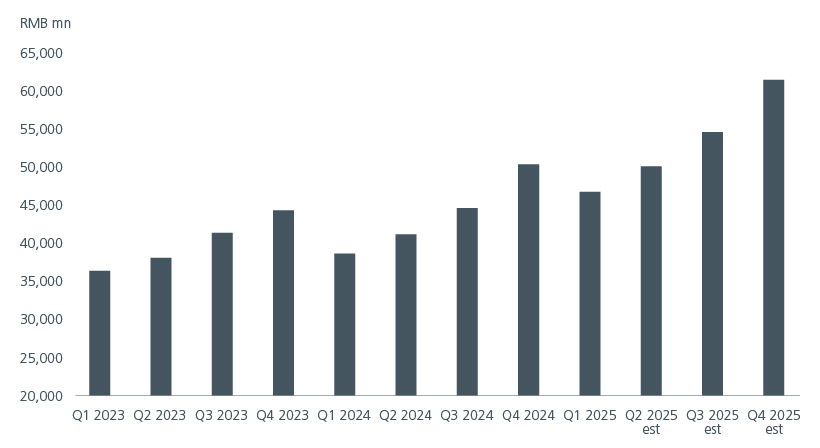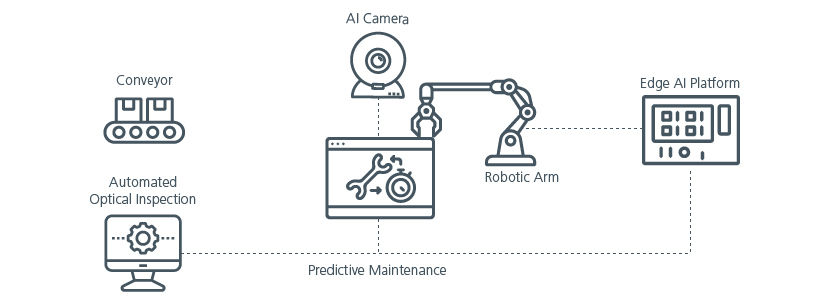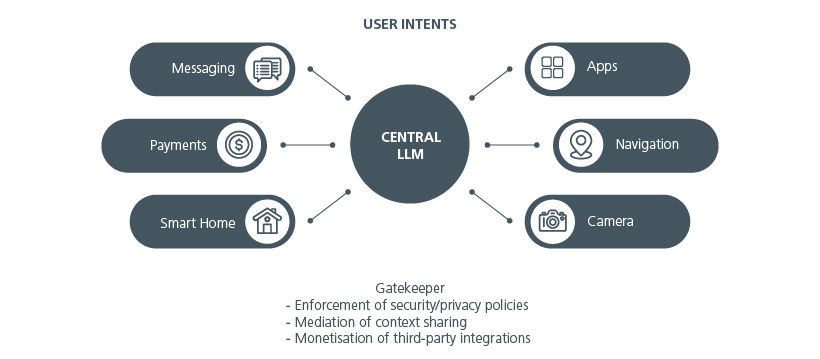Executive Summary
- Rising adoption, robust capex plans and emerging use cases strengthen the AI growth narrative where Asia is a key enabler and innovator.
- Frequent shifts in sentiment create significant volatility within AI-related stocks. Such dislocations are alpha opportunities for active investors.
- A value-centred approach can capture AI’s long-term growth upside while sidestepping frothy valuations, delivering consistent returns amid the noise.
Artificial intelligence (AI) is emerging as a foundational technology for the future. This can be seen from the robust capital spending by US and China hyperscalers. At the latest US earnings results season in May, selected US hyperscalers guided their capex forecasts higher. The CEO of the world’s largest hyperscaler also commented that their AI capacity is being used up as fast as it is put in, calling out supply bottlenecks in motherboards and components.
However, short-term ebbs and flows in market sentiment are common with structural themes. More recently, the AI narrative was affected by recession fears arising from the US tariffs, rumours of capex cuts by US hyperscalers, and poor manufacturing yields of advanced server racks. In addition, the apparent lack of monetisation of popular chatbots, concerns over the commoditisation of Large Language Models (LLMs) and falling Graphics Processing Unit (GPU) rental rates also contributed to significant volatility in AI-related stocks. Such market dislocations present opportunities for active investors to generate alpha.
Inferencing at scale
Given Asia’s role as an enabler and innovator, there are multiple opportunities across the region’s AI ecosystem. Strong capex growth by US hyperscalers should benefit Taiwanese and Korean AI chip supply chain players especially in the areas of foundry, High Bandwidth Memory (HBM), ABF substrate (Ajinomoto Build-Up Film), PCBs (Printed Circuit Boards), ASIC (Application Specific ICs) backend design, and server assembly.
Asia is home to almost 60% of the global population which represents a huge base of end users that generate data. As demand for AI-powered services rises in the region, the need for low-latency, high performance AI inferencing becomes critical. As such, US and China hyperscalers are expanding their cloud presence in the region to be closer to the end users.
Given the significant capital requirements and local presence needed to secure land and power in the region, third party data centre providers are well positioned to capitalise on the growing demand for AI inferencing through leasing arrangements with hyperscalers. Governments and multinationals are also driving demand for regional data centre capacity. Co-locating with other services saves costs and reduces latency. At the same time, many companies prefer to retain some of their own computing capacity rather than relying entirely on hyperscalers due to concerns over data sovereignty, security and control.
In Korea and Malaysia, leading data centre providers are planning to more than double their existing capacity. In Singapore, there is a capacity constraint due to a government-imposed moratorium on new data centres. However, as enterprises prefer to keep their regional data in Singapore due to a stable legal and political environment, third party data centre providers can enjoy premium rental rates that are 4x higher than the industry average.
At the same time, Chinese hyperscalers are driving revenue growth by moving beyond low value GPU rental services and enabling enterprise-level AI transformation by offering Model as a Service (MaaS). Fig. 1. These services can be customised for specific industries, supporting applications ranging from front-end customer facing chatbots to back-end risk management tools like fraud detection. By offering MaaS alongside traditional cloud services such as compute, databases and storage, Chinese hyperscalers are creating sticky ecosystems.
Fig. 1. China hyperscalers cloud revenue growth

Source: Visible Alpha (subsidiary of S&P Global). May 2025.
Solving real world problems
We are seeing more AI use cases emerge in Asia. This will drive broader AI adoption, in turn fuelling demand for AI infrastructure and compute resources. For example, a leading Taiwanese semiconductor chip manufacturer is leveraging a cutting-edge AI computational lithography platform to enhance its production of photomasks – critical tools used to imprint circuitry onto chips. The company notes that every 1% of productivity gain yields cost savings of NT$1 bn. Fig. 2. In another example, a major electronics contract manufacturer in Taiwan is utilising an advanced edge AI platform in its smart manufacturing process, applying it to tasks such as robotic arm control and optical inspection to boost precision and automation on the factory floor. Fig. 3.
Fig. 2. Applications of AI chips at a leading semiconductor chip manufacturer

Source: Eastspring Investments. May 2025. Original image is AI generated. OPC: Optical Proximity Correction. EDA: Electronic Design Automation.
Fig. 3. Leveraging edge AI platform in smart manufacturing

Source: Eastspring Investments. May 2025. Original image is AI generated.
Consumer-facing AI has been slower to see breakthrough in major use cases, with chatbots currently being the primary use case. But some smartphone makers in China are rolling out their own AI-augmented operating systems with writing, editing and translation capabilities. These developments increasingly position smart phones in competition with existing dominant application ecosystems.
In a future where agentic AI becomes central to the smartphone experience, system-level AI agents—bundled directly into the operating system—could manage cross-app workflows by default. This shift may challenge the traditional role of app stores, as these system agents begin to control user interactions and data flows, potentially unlocking new gatekeeper economics for device makers. Fig. 4.
Fig. 4. Agentic AI becoming central to the smartphone experience

Source: Eastspring Investments. LLM: Language Learning Model. Original image is AI generated.
A value-centred approach
These dynamics across Asia—from the chip fabs in Taiwan and HBM in Korea, to China’s hyperscalers and the region’s third-party data centres and enterprise adopters—are not just a secular growth story. They are fertile ground for disciplined value investing when trying to identify beneficiaries of the structural AI theme. A margin of safety approach allows us to buy on scepticism and profit as fundamentals re-assert themselves. Focusing on companies with durable competitive advantages at attractive valuations enables us to capture AI’s long-term growth upside while sidestepping frothy valuations. In markets that oscillate between euphoria and skepticism, a patient, value-centric process can help deliver consistent returns amid the noise.
Sources:
1 Amrkit iBoxx ALBI (USD unhedged).
Singapore by Eastspring Investments (Singapore) Limited (UEN: 199407631H)
Australia (for wholesale clients only) by Eastspring Investments (Singapore) Limited (UEN: 199407631H), which is incorporated in Singapore, is exempt from the requirement to hold an Australian financial services licence and is licensed and regulated by the Monetary Authority of Singapore under Singapore laws which differ from Australian laws
Hong Kong by Eastspring Investments (Hong Kong) Limited and has not been reviewed by the Securities and Futures Commission of Hong Kong.
Indonesia by PT Eastspring Investments Indonesia, an investment manager that is licensed, registered and supervised by the Indonesia Financial Services Authority (OJK).
Malaysia by Eastspring Investments Berhad (200001028634/ 531241-U) and Eastspring Al-Wara’ Investments Berhad (200901017585 / 860682-K) and has not been reviewed by Securities Commission of Malaysia.
Thailand by Eastspring Asset Management (Thailand) Co., Ltd.
United States of America (for institutional clients only) by Eastspring Investments (Singapore) Limited (UEN: 199407631H), which is incorporated in Singapore and is registered with the U.S Securities and Exchange Commission as a registered investment adviser.
European Economic Area (for professional clients only) and Switzerland (for qualified investors only) by Eastspring Investments (Luxembourg) S.A., 26, Boulevard Royal, 2449 Luxembourg, Grand-Duchy of Luxembourg, registered with the Registre de Commerce et des Sociétés (Luxembourg), Register No B 173737.
Chile (for institutional clients only) by Eastspring Investments (Singapore) Limited (UEN: 199407631H), which is incorporated in Singapore and is licensed and regulated by the Monetary Authority of Singapore under Singapore laws which differ from Chilean laws.
The afore-mentioned entities are hereinafter collectively referred to as Eastspring Investments.
The views and opinions contained herein are those of the author, and may not necessarily represent views expressed or reflected in other Eastspring Investments’ communications. This document is solely for information purposes and does not have any regard to the specific investment objective, financial situation and/or particular needs of any specific persons who may receive this document. This document is not intended as an offer, a solicitation of offer or a recommendation, to deal in shares of securities or any financial instruments. It may not be published, circulated, reproduced or distributed without the prior written consent of Eastspring Investments. Reliance upon information in this document is at the sole discretion of the reader. Please carefully study the related information and/or consult your own professional adviser before investing.
Investment involves risks. Past performance of and the predictions, projections, or forecasts on the economy, securities markets or the economic trends of the markets are not necessarily indicative of the future or likely performance of Eastspring Investments or any of the funds managed by Eastspring Investments.
Information herein is believed to be reliable at time of publication. Data from third party sources may have been used in the preparation of this material and Eastspring Investments has not independently verified, validated or audited such data. Where lawfully permitted, Eastspring Investments does not warrant its completeness or accuracy and is not responsible for error of facts or opinion nor shall be liable for damages arising out of any person’s reliance upon this information. Any opinion or estimate contained in this document may subject to change without notice.
Eastspring Investments companies (excluding joint venture companies) are ultimately wholly owned/indirect subsidiaries of Prudential plc of the United Kingdom. Eastspring Investments companies (including joint venture companies) and Prudential plc are not affiliated in any manner with Prudential Financial, Inc., a company whose principal place of business is in the United States of America or with the Prudential Assurance Company Limited, a subsidiary of M&G plc (a company incorporated in the United Kingdom).













